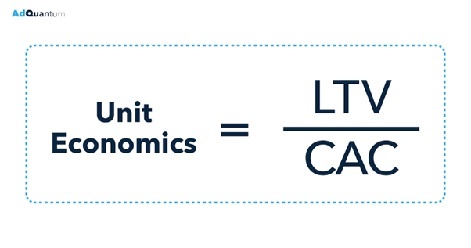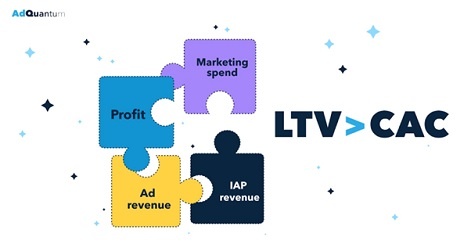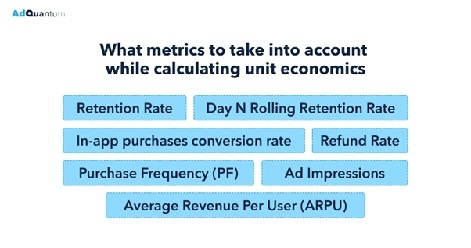Do you have a mobile application but still cannot monetise it properly? Puzzled over what else to do to make your app earn? If you never ever calculated your unit economics, now is the perfect time to deal with it. In this article, performance marketing agency AdQuantum's account director Pavel Belov fields questions about mobile app unit economics and gives you tips on how to calculate it properly and possibly increase it.
What is unit economics, who needs it, and why
Any business has its unit economics, no matter the specifics. The essence of unit economics is simple. To figure it out, you only have to know two things:
a. How much do you spend on acquiring one client? Here you’ll need a customer acquisition cost (CAC).
b. How much do you earn on one client? This also refers to lifetime value (LTV).

If the difference between a. and b. is above 0, then congratulations — you have positive unit economics. But will this be enough for your business as a whole to be considered profitable?
Generally speaking, unit economics is the level of profitability of your business. As for who needs it, basically, every business owner has to calculate their business’s unit economics once in a while to comprehend if a project can be scaled. If yes, in what perspective, and if not at all, then does it even make sense to continue evolving this project, or is it better to revise it somehow? Without understanding at least the basic principles of unit economics, your product won’t likely grow and certainly won’t become a unicorn.
On average, 20-30% of gross profit is quite a good result for a mobile app. This percentage doesn’t include the profit from organic traffic, however. Yet, if you worked out your unit economics and found out it’s negative, do not rush to worry. It depends on to what extent it’s negative. If it’s just slightly negative, you can raise it to 10-15%, and with this level of profit, you will likely pull through. Gradually you will make it better and better.
However, if we talk about 90% negative unit economics, we have bad news for you… You’ll probably need to rework your business. To estimate it objectively, you can ask a mobile app publisher or a third-party consultant for help.
What does unit economics depend on and what does it influence
There are several aspects that any business’s unit economics depends on. Among them is marketing. In the case of mobile apps, it’s user acquisition spending and these aspects in particular:
• Do users pay in the app or game?
• Do they watch in-app ads?
• Do they actually use your app?
• Do you use additional ways to engage users, such as push notifications, promotions, or in-app ads?

All of the abovementioned boost your app’s users' lifetime value (LTV) and consequently improve the unit economics.
As for what unit economics influence, when your unit economics is negative, you simply cannot get your project profitable and scaled no matter how much money you invest into marketing. You will run at a loss, and eventually, you will have to end your project.
What metrics to take into account while calculating unit economics
Besides CAC and LTV, there are some other metrics you should pay attention to in order to properly work out your unit economics.
• Retention Rate (RR) — the percentage of users who continue engaging with an app over time. This metric is typically measured on day 1, day 7, and day 30 after users first install the app. RR is calculated by dividing an app's monthly active users by its monthly installs. This is a crucial metric for understanding to what extent users are interested and ‘retained’ in your app. The ‘satisfactory’ level of RR is a relative thing. If you’d like to know what would be a good RR for your app specifically, reach out to AdQuantum and we’ll share benchmarks for your app vertical.
• Day N Rolling Retention Rate (RRR) — the percentage of users who returned to the app on/after N days of installation. It’s important to know because if users do not return to your product, they will not pay. The rolling retention rate is calculated by dividing the number of users who engaged with the app on the day N (or later) by the number of users who installed the app N days ago multiplied by 100%. For example, if one user returned to the application on day 7 and day 14, and the second user did it on day 13, then when calculating Rolling Retention D7, they will be considered two users who returned on day 7.
• In-app purchases conversion rate — the number of purchases in your mobile app or game. This can be either app subscription purchases or in-app purchases. IAP conversion rate refers to the percentage of users who complete an in-app purchase within a free game or app. For instance, if you had 100 people using your free app and 3 of them made some sort of purchase within the app, your IAP conversion rate would be 3%.
• Purchase Frequency (PF) — the number of times a customer makes a purchase in a specified period. This metric gives you an additional understanding of how a user is engaged in your app and how loyal they are to it. PF also indicates an ability to identify these users for better lookalike targeting and remarketing. For example, you can potentially reward or exclude them from paid remarketing campaigns.
• Ad Impressions — the number of views on a particular ad. It’s important to maintain balance if we talk about mobile games. Those users who don't pay in games watch a lot of ads. And those who pay also watch ads, but less. Each new ad impression from one person brings less money to the publisher. In mobile marketing, this phenomenon is called eCPM decay. It’s when your effective cost per thousand impressions starts dropping dramatically. Working with mediation on the user level will help slow down the decay.
• Average Revenue Per User (ARPU) — the amount of revenue generated from each customer on average. ARPU always fluctuates depending on GEO, app vertical, and monetization model. As such, there’s no satisfying range for this metric. However, for example, for casual games in Tier-1 countries, the average ARPU is around $1.96.
• Refund Rate — the percentage of the total transactions that were refunded during a given period of time. It is calculated by the number of refunds divided by the number of purchases. A good range is somewhere between 2% and 7%.

How to calculate your unit economics
When you don’t know how much money users bring to you, you won’t be able to purchase mobile traffic efficiently in the long run. You’ll be blindfolded, which always leads to the failure of the project, sooner or later. Therefore, here’s a How-To on calculating your app’s unit economics. Firstly, let’s define who should handle this calculation.
If a developer works with a publisher, then all the calculations are on the publisher’s side. If not, normally, unit economics is calculated by analytics and a marketing team combined. The marketing team is as crucial here as the analytics one because the users’ LTV might differ depending on the traffic source, ad campaign optimization, and many other things. Therefore, a marketing team will advise analysts on where to pay special attention when evaluating LTV in your exact case.
What data do you need to calculate your unit economics? You should collect your data from MMP and your own database if you have one.
The easiest way to estimate your unit economics is to compare your CAC and LTV. If the CAC is lower than the LTV then you have positive unit economics. If it is the other way around, then negative accordingly.
You have to regularly carry out recalculations as the development of the project does not stand still, therefore your unit economics may vary significantly with new content updates or changes in user acquisition strategy.
Typically, mobile publishers tend to recalculate a product’s unit economics once a quarter. But in general, it's better to do so with every massive game or app update. Or for instance when you've fixed a bunch of bugs. Always recalculate your unit economics when you make some huge updates, as it will inevitably change.
How to improve your unit economics
To discover what exactly will help you improve the situation with your unit economics, you have to:
1. Compare your metrics with the same app category benchmarks
2. Analyse user reviews
3. Make sure the analytics in your app is set up correctly and the data you see is actually true
Even though there’s no magic pill and every case should be considered individually, there are several common things that might help increase your unit economics. Generally, to improve your unit economics, you either have to increase LTV or decrease CAC, or both at once. Try taking these steps to do so:
• Implement new features and content. And always remember that new content will not only influence new users but the existing ones as well.
• Find the best traffic sources for your app, and cheapest isn’t always best in this case. For instance, an ad network with cheap traffic might work at a loss, whereas a paid social traffic source with expensive traffic might generate results multiple times higher.
• Eventually compare information on payments in your MMP (mobile measurement partner) and your Developer Console. This is the only way you can understand how many real payments you have.
• Never stop looking for new key ad creatives, as creatives make up 80% of your app’s success.
• Study your competitors and implement best-practice approaches to your own app through A/B tests.
• Implement special events in your app or game. For instance, a Halloween sale, Christmas or Thanksgiving gifts — this gives you seasonal boosts.
• Use push notifications and retargeting — this way, you will remind your users about yourself.
• Try different user acquisition partners and find the best ones for you.
• Do not forget about influencer marketing if this channel fits your app. Influencer marketing greatly increases your user base. A well-chosen influencer will bring a more relevant and interested audience to your app than targeted advertising.
• Conduct an audit of your ad campaigns. It might reveal that your current ad campaigns aren’t very efficient. AdQuantum will conduct a free-of-charge audit for you and help you find out your app’s pitfalls and points of growth. Reach out to us to explore new horizons of your app or game.
Edited by Lewis Rees





















